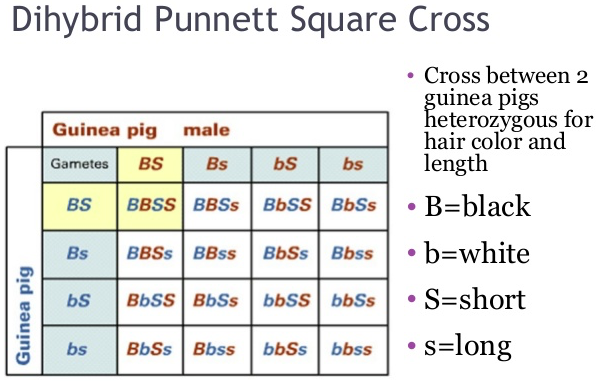| We can predict the genes likely to be inherited by the puppies if we know the genotypes of both of the parents from DNA testing. You have probably seen some busy-looking illustrated examples like the one to the right of the phenotypes to expect from the genotypes of the parents. These are useful for illustration, but most people (well, speaking for myself) can't just memorize the illustration. In fact, there is an easier way to figure out the phenotypes to expect from particular genotypes and you don't have to memorize a thing. |

To do this, we can use something called a Punnett Square. Reginald Crundall Punnett was a British scientist that finished his degree in 1898 when things on the cutting edge of genetics were really getting hot. Experiments on Mendelian genetic inheritance of simple traits like size and flower color in sweet peas all the rage, and the concepts of recessive and dominant were throwing new light on the understanding of inheritance.
Punnet wanted to work out a simple way to predict the traits - the phenotypes - that would be inherited from parents. Knowing that each individual has paired alleles for a trait, one inherited from each parent, he came up with the Punnet square. Here's how it works.
Now, to see what we do next, click on this little alien that can't wait to show you the basics -
Knowing how to do a Punnett square, you can figure out the predicted proportions of phenotypes from combinations of parents with any genotype. So you don't need to memorize a busy chart like this one. Just sketch a square with four quadrants on the back of a napkin and work it out in seconds.
| If fact, to convince yourself that you've got this, why don't you see if there are any errors in this one that has been circulating on Facebook! Remember to represent "clear" as AA (or whatever letter you want to use), "carrier" as Aa, and "affected" as homozygous recessive, or aa. Just remember that these are probabilities. If you (OMG) were to have a litter of 100 puppies (or puppies from the matings of many parents with the same genotypes), you can expect to come close to the predictions from your Punnett square. But the alleles inherited by each puppy are random. As you know from flipping a coin, you shouldn't expect to get 5 heads and 5 tails from 10 tosses every time. But flipped 50 times it should be closer to 50:50, and 100 flips is likely to come close. |
The Punnett square works just as well for predictions of two traits at a time. Here's an example of a "dihybrid" cross involving two genes in guinea pigs, one for coat color and the other for coat length. The Punnett square makes it easy to map out all 16 possible combinations of inheritance in just a minute or two.
Have a go at checking the red, blue, and greed Ridgebacks and see if you get the same results for each pair of parents on the left. And below are some other examples you can play with. By the time you've worked through these, you'll be a pro!
*** MANAGING GENETICS FOR THE FUTURE ***
Join us!
ICB's online courses
***************************************
Visit our Facebook Groups
ICB Institute of Canine Biology
...the latest canine news and research
ICB Breeding for the Future
...the science of animal breeding








